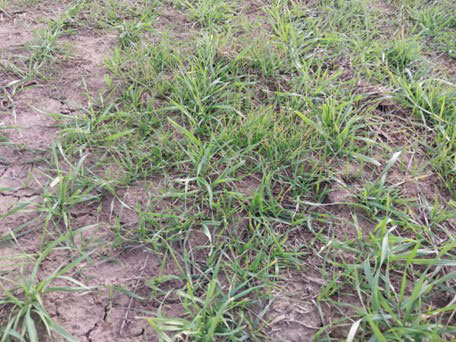Beneficial rains have brought much-needed moisture to the Kansas wheat crop. However, the moisture can also trigger winter annual weeds, especially in fields with poor wheat stands or where continuous wheat or wheat-fallow rotations are used. This article will focus on the grass weeds common in wheat.
Like wheat, winter annual grasses typically emerge in the fall (although early spring emergence is possible). They go dormant during the coldest months, then resume growth and produce seeds in the spring. The weedy brome species cheatgrass (also known as downy brome), Japanese brome, and cheat are among the grass weeds most commonly found in Kansas wheat (Figure 1). Jointed goatgrass and feral rye are also prevalent and are especially challenging to control. Cheat and feral rye are typically found in the eastern parts of the state, whereas cheatgrass and jointed goatgrass are more often found in the west. Table 1 provides a list of postemergence herbicides labelled for these species and their efficacy on each species.

Figure 1. Cheatgrass (downy brome) growing in winter wheat. Photo by Patrick Geier, K-State Research & Extension.
Table 1. Postemergence herbicides for controlling winter annual grasses in Kansas.
|
Herbicide |
Cheat (downy brome) |
Cheatgrass |
|
|
|
|
Aggressor (CoAXium wheat only)2 |
G-E |
G-E |
G-E |
G-E |
G-E |
|
Batalium Amped |
F-G |
F-G |
F-G |
P-F |
- |
|
Beyond Xtra (Clearfield wheat only)2 |
E |
G-E |
E |
E |
G |
|
Everest 3.0 |
G-E |
P-F |
G-E |
- |
- |
|
Metribuzin |
F-G |
F |
G |
- |
- |
|
Olympus |
E |
F-G |
E |
P |
- |
|
Osprey |
F |
F |
F |
- |
- |
|
Outrider |
G-E |
F-G |
G-E |
- |
- |
|
Powerflex HL, GR1 |
E |
F-G |
E |
- |
- |
|
1 Ratings: E = excellent, G = Good, F = fair, P = poor, - = weed not listed on herbicide label. Products with residual activity are in bold. 2 Application of Aggressor to non-CoAXium wheat or Beyond Xtra to non-Clearfield wheat will result in severe crop injury. |
|||||
Considerations for Herbicide Applications
As a general rule, fall applications will provide better control of these weeds than spring applications. However, it is important to remember that weeds must be actively growing for herbicides to be effective. Be aware of the temperatures in your area to ensure weeds are not dormant. One temperature guideline to consider using is low temperatures above freezing and high temperatures above 50°F for three to five days before and after the application. Delaying applications until spring, when herbicide can be mixed with topdress fertilizer, is an option, although this can lead to greater yield loss due to competition and reduced herbicide efficacy. Furthermore, spring applications may not meet crop rotation intervals. Always read the herbicide label to determine recropping intervals and adjuvant requirements.
The growth stage is also important when applying several of these herbicides. For example, Aggressor herbicide should be applied between the 4-leaf to jointing stage, before the grassy weeds exceed the 4- to 5-leaf stage. Beyond Xtra can be applied to one gene Clearfield varieties between tiller initiation and jointing, and the two-gene Clearfield Plus varieties between the 2-leaf and the second joint stage of growth. Batalium Amped can start to be applied at the 2-leaf stage. Outrider can be applied after wheat is in the two-leaf stage, but before the jointing stage in the spring. Olympus can be applied after emergence but before the jointing stage. However, applications before wheat tiller initiation have a greater risk of stunting the crop.
Other Options: Crop Rotation and Seed Destruction
Crop rotation is an effective method of preventing winter annual weeds in wheat. One or more summer annual crops between wheat crops disrupts the life cycle of winter annual weeds, allowing for the use of other cultural and chemical methods for their control. Narrower row spacings or increased wheat seeding rates can make wheat more competitive with weeds. In dry environments, seeding wheat deeper into moist soil may allow wheat to emerge before weedy brome seeds that must germinate from dry soil nearer the soil surface. Alternatively, delaying planting until after the first flush of weedy grasses has emerged may also be an effective cultural management practice when moisture is abundant.
Seed destruction of some winter annual grasses (cheatgrass, feral rye, and jointed goatgrass) at wheat harvest may be a viable option to reduce the amount of weed seed that returns to the soil seedbank, which may reduce the density of winter annual grasses in the following seasons. More information on harvest weed seed destruction can be found at: https://eupdate.agronomy.ksu.edu/article/harvest-weed-seed-destruction-a-tool-for-managing-herbicide-resistant-weeds-601-1
Summary
Several effective options exist to control weedy brome species. Jointed goatgrass and feral rye control options are more limited and will likely require planting either a Clearfield or CoAXium wheat variety. In fields where winter annual grasses are known to be a problem, cultural practices can be implemented to reduce their impact, such as using an herbicide-resistant wheat variety or rotating to a summer crop
For additional information about these herbicides, see 2025 Chemical Weed Control for Field Crops, Pastures, Rangeland, and Noncropland, K-State publication SRP-1190.
The use of trade names is for clarity to readers and does not imply endorsement of a particular product, nor does exclusion imply non-approval. Always consult the herbicide label for the most current use requirements.
Patrick Geier, Weed Scientist, Garden City
pgeier@ksu.edu
Logan Simon, Southwest Area Agronomist, Garden City
lsimon@ksu.edu
Sarah Lancaster, Extension Weed Management Specialist
slancaster@ksu.edu
Jeremie Kouame, Weed Scientist, Agricultural Research Center – Hays
jkouame@ksu.edu
Jeanne Falk Jones, Northwest Area Agronomist, Colby
jfalkjones@ksu.edu